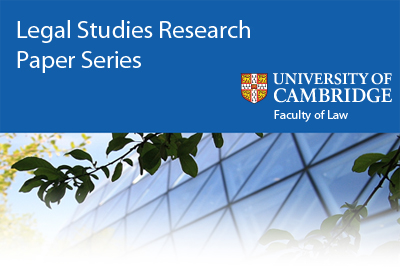 The Faculty has distributed Volume 15 Number 8 of the University of Cambridge Faculty of Law Legal Studies Research Paper Series on SSRN.
The Faculty has distributed Volume 15 Number 8 of the University of Cambridge Faculty of Law Legal Studies Research Paper Series on SSRN.
This issue includes the following articles:
Raffael N Fasel: Pouvoir constituant limité: A theory of limited constituent power (28/2024)
The concept of constituent power is facing increasing resistance. Condemned for its susceptibility to abuse, its incompatibility with the international legal order, and its romanticisation of elite-driven constitution-making processes, critics are calling for it to be abandoned. However, such calls are premature. This article demonstrates that a potent theory of constituent power can be developed to address these challenges: the theory of pouvoir constituant limité. By reviving the once-dominant non-positivist tradition of constituent power, I argue that constituent power should be understood as the people’s power to make constitutional choices, constrained by norms such as the peremptory norms of international law, which have both a moral and legal character. I contrast this theory with three prevalent approaches to constituent power – decisionism, normativism, and relationalism – and show that pouvoir constituant limité is uniquely equipped to meet the challenges of constituent power while preserving its democratic potential.
Christina Angelopoulos: Articles 15 & 17 of the Directive on Copyright in the Digital Single Market -Comparative National Implementation Report (29/2024)
This report examines the national implementation of Articles 15 and 17 of the EU’s Directive on Copyright in the Digital Single Market (DCDSM) in 25 Member States. The first introduced new rights for press publishers and the second a special copyright liability scheme for certain online platforms (“online content-sharing services providers” or OCSSPs). The report analyses the responses of national experts from each Member State to a questionnaire organised around a set of identified assessment criteria. The objective was to evaluate the compatibility of the national implementations with the goal of establishing of a digital single market and with the EU law of fundamental rights. The analysis determined that all 25 examined Member States exhibit implementation irregularities. Incompatibilities take a variety of forms, including elaboration on the EU rules, additions to and omissions from those rules and incorrect interpretation of autonomous notions of EU law. They may result from national “homing tendencies” and often lead to expansions (“gold-plating”) or contractions of the scope of the EU rules, as well as to legal uncertainty. The resultant disharmonisation is attributable both to errant national implementation and to faulty drafting at the EU level.
Catherine Barnard & Sarah Fraser Butlin: Another Example of the Blurred Boundaries Between Contract Law and Labour Law: Reflections on Cox v Secretary of State for the Home Department (31/2024)
The case of Cox exemplifies the ongoing tension that exists in labour law between taking a pure contractual approach and the need to modify traditional contract principles to recognise the distinctive nature of employment relations. We will argue that the real difficulty in the case lies in a lack of clarity about the role of the law in relation to trade unions. Over recent years, the law has adapted to ensure that individual employees are properly protected vis a vis their relationship with employers, particularly where the protection arises from a person’s ability to enforce their statutory rights. The reasoning for the shift in approach has rightly been concerned with preventing the exploitation of employees who are in a weaker bargaining position relative to their employer. However, when the position of trade unions is considered, the law has not adopted a similar approach. Instead, the law has consistently emphasised the traditional view of matters relating to trade unions belonging in the industrial sphere and a real hesitation about the role of the law in the employer-trade union relationship. In Cox, the Supreme Court will have to grapple with the very clear wording of the statute and particularly the phrase “on a proper construction of the contract” and consider the extent to which it matters that the third party in this case is a trade union and the underlying agreement is an unenforceable collective agreement.
Huiyuan Xie, Felix Steffek, Joana Ribeiro de Faria, Christine Carter & Jonathan Rutherford: The CLC-UKET Dataset: Benchmarking Case Outcome Prediction for the UK Employment Tribunal (32/2024)
This paper explores the intersection of technological innovation and access to justice by developing a benchmark for predicting case outcomes in the UK Employment Tribunal (UKET). To address the challenge of extensive manual annotation, the study employs a large language model (LLM) for automatic annotation, resulting in the creation of the CLC-UKET dataset. The dataset consists of approximately 19,000 UKET cases and their metadata. Comprehensive legal annotations cover facts, claims, precedent references, statutory references, case outcomes, reasons and jurisdiction codes. Facilitated by the CLC-UKET data, we examine a multi-class case outcome prediction task in the UKET. Human predictions are collected to establish a performance reference for model comparison. Empirical results from baseline models indicate that finetuned transformer models outperform zero-shot and few-shot LLMs on the UKET prediction task. The performance of zero-shot LLMs can be enhanced by integrating task-related information into few-shot examples. We hope that the CLC-UKET dataset, along with human annotations and empirical findings, can serve as a valuable benchmark for employment-related dispute resolution.
Interested readers can browse the Working Paper Series at SSRN, or sign up to subscribe to distributions of the the e-journal.


 Facebook
Facebook  X/Twitter
X/Twitter  Instagram
Instagram  YouTube
YouTube  Flickr
Flickr  LinkedIn
LinkedIn